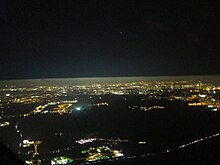Peplosphere
As planetary boundary layer , planetary boundary layer or atmospheric boundary layer ( English atmospheric boundary layer ) of the lower part of which is the Earth's atmosphere called the to the earth's surface is adjacent and in particular by ground friction and heating -turbulence causing the time range of hours is affected. Typically this is the lowest 1.5 to 2 kilometers in height, depending on wind and temperature conditions.
The peplosphere is literally the “airy garment” that envelops the surface of the earth ( analogous to the peplos as a woman's dress).
particularities

The city's light is heavily scattered below the boundary layer, and above it it propagates into space.
In this boundary layer of the atmosphere lies the primary engine of weather events . Here the energy radiation from the sun ( visible light , see solar constant ) shows great effects, as does the upward radiation (light and infrared ). This makes it the most turbulent layer in the atmosphere with a large amount of convection . Different heat reflection ( albedo ) of the earth's surface - for example by vegetation and slope of the land - cause local up , slope and downdrafts , particularly among and between the clouds (see gliding ).
The planetary boundary layer is - in contrast to the larger part of the overlying troposphere ( free atmosphere ) - characterized by the fact that the geostrophic wind is slowed down by ground friction. As a result, it no longer blows parallel to the isobars as at higher altitudes , but rather in the direction of the lower air pressure . The inflow of air close to the ground into the low pressure areas is compensated by aliquot compensatory winds just below the tropopause . Some temperature and, above all, wind effects of the planetary boundary layer that differ from the free atmosphere are compensated for at higher altitudes near the tropopause by winds in the opposite direction.
In the planetary boundary layer, a layer of haze often forms due to the accumulation of aerosols. Mountaineers see the upper edge of the planetary boundary layer when the valleys are in the early morning fog , but the higher mountain slopes are already in the sunshine. Even when flying through a few minutes after take-off, this boundary layer stands out from the blue of the sky . In so-called radiation nights (clear sky), this area of the atmosphere shows a strong nightly cooling due to thermal radiation into space, which can form fog and long-lasting high fog .